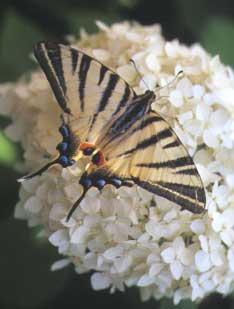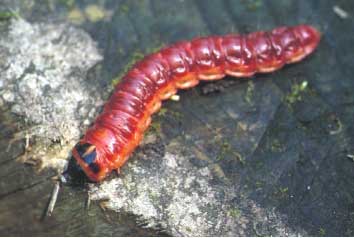On examination of the butterflies we realiste that the beauty of their wing colours has few equals in the animal world. The Purple Emperor Apatura iris (Linne, 1758) and Apatura ilia (Denis & Schiffermuller, 1775) on show have shadings in their colouring that change from brown to blue-violet, depending on the angle from which they are seen.
This effect, a male prerogative, is caused by diffraction and reflection of light on the wing scales; the females, with differently structured wing scales, are without this feature. Even common butterflies like the Swallowtail, Papilio machaon (Linne, 1758) and Scarce Swallowtail, Iphiclides podalirius (Linne, 1758) cannot help but amaze us with the beautiful shape of their wings ending in two long tails.
If the stag beetle is the biggest of the European beetles, the Emperor Moth, Saturnia pyri (Denis & Schiffermuller, 1775) is the biggest indigenous European moth, reaching a 13cm wing spread. The adult has a pattern with 4 threatening eyes on its wings which seems designed to scare possibile predators such as birds. Since the mouth of the moth is atrophied as an adult it cannot feed, so it lives as long as the energy it accumulated in its body as a larva lasts.
Another large creature is the Death’s Head Hawkmoth, Acheronthia atropos (Linne, 1758). This macabre name comes from the strange yellowish pattern on the adult’s back which looks like a skull. Unlike other species which for sucking nectar have a long proboscis in a coil, this moth has a short, thick proboscis which enables it to perforate the operculum of the honey cells in beehives in order to feed.
Naturally when it penetrates the hive the worker bees try to neutralize it by stinging it, but this moth has a very thick, hairy skin which protects it against the stings. It also emits a high shriek when disturbed which recent studies show as similar to that of the Queen Bee, so the moth’s sound seems to imitate one that would calm down the aggressive workers.
Lastly in this section on butterflies and moths it is worth spending a few words the Goat Moth, Cossus cossus (Linne, 1758), also known as the “red wood-gnawer”. Rather than discussing the moth, a brown-grey creature with black streaks, it is interesting to look at the caterpillar, up to 7 or 8 cm long and bright red. It takes three years to develop before becoming a crysalis and can dig long tunnels in large branches or tree trunks of various species such as poplars, willows. elms and plane trees.
The tunnels, the width of a finger, can be found from the eveidence on the ground beneath it; and on the trunk the hole is usually surrounded by the gnawed wood and sap running down the bark. These tunnels may go the whole length of the tree and consequently cause serious damage to the life and stability of the trees attacked.
For this reason this wood-gnawing moth is held to be one of the most damaging for agricultural and forestry activities.

